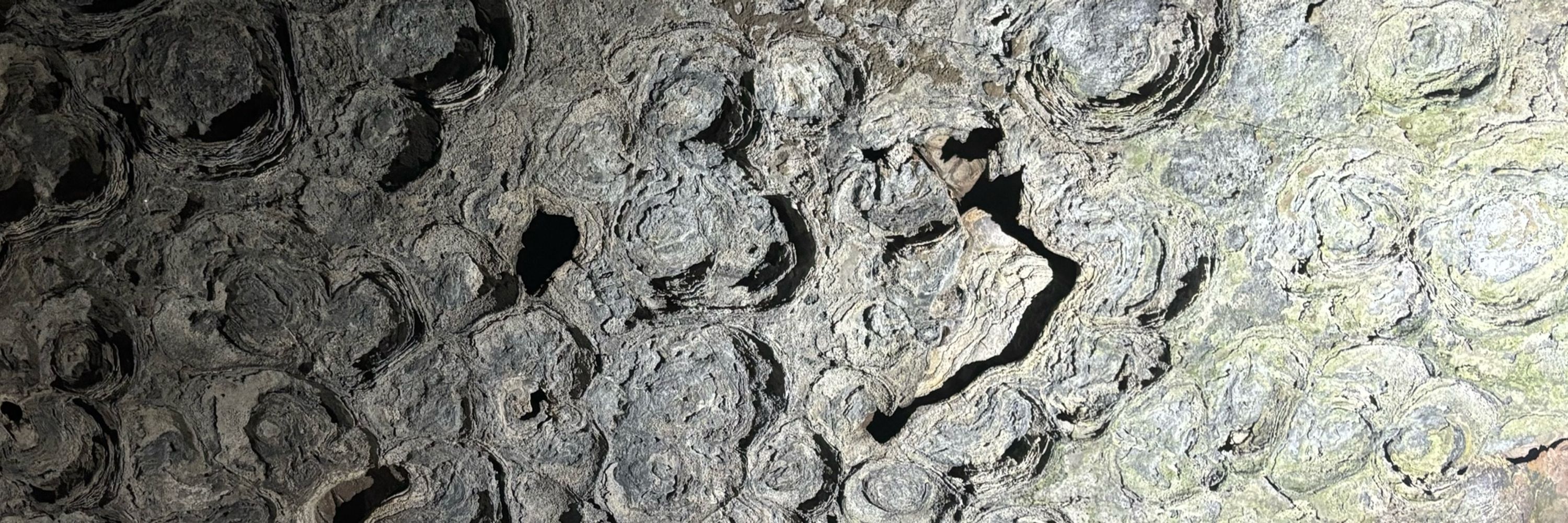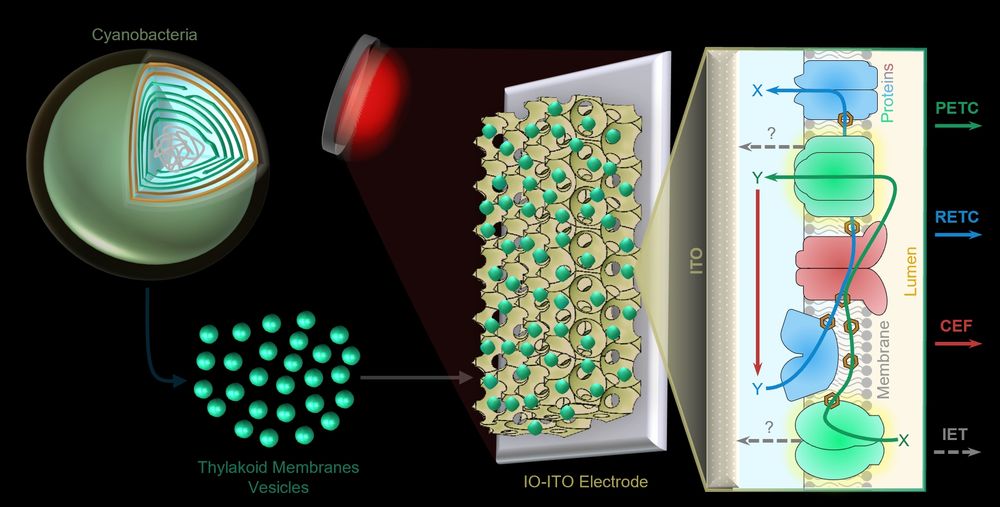
Josh Lawrence
@jmlawrence.bsky.social
Research Fellow at Trinity Hall and Chemistry Department of the University of Cambridge | he/him
This technique (native membrane electrochemistry) combines the interpretability of protein electrochemistry with the complexity of microbial electrochemistry. We envision applications in investigating #bioenergetics, as well as #bioelectricity and #biocatalysis. (9/10)

July 21, 2025 at 11:05 AM
This technique (native membrane electrochemistry) combines the interpretability of protein electrochemistry with the complexity of microbial electrochemistry. We envision applications in investigating #bioenergetics, as well as #bioelectricity and #biocatalysis. (9/10)
We also identified how wiring membranes to electrodes has inherent advantages in #biohybrid devices for energy conversion. Here we obtain photocurrents at -600 mV vs SHE; ~1V more negative (much higher energy electrons) than is achievable with isolated proteins. (8/10)

July 21, 2025 at 11:05 AM
We also identified how wiring membranes to electrodes has inherent advantages in #biohybrid devices for energy conversion. Here we obtain photocurrents at -600 mV vs SHE; ~1V more negative (much higher energy electrons) than is achievable with isolated proteins. (8/10)
We also showed how these electrochemical measurements can be coupled to spectroscopy, with parameters from each showing agreement with one another. (7/10)

July 21, 2025 at 11:05 AM
We also showed how these electrochemical measurements can be coupled to spectroscopy, with parameters from each showing agreement with one another. (7/10)
This alone demonstrates that electrochemistry can interrogate complex biological systems, but what can we actually use it for? Here we use the Spike Charge to measure respiratory reduction and oxidation of the #quinone pool (↑Spike Charge = ↑quinone reduction). (6/10)

July 21, 2025 at 11:05 AM
This alone demonstrates that electrochemistry can interrogate complex biological systems, but what can we actually use it for? Here we use the Spike Charge to measure respiratory reduction and oxidation of the #quinone pool (↑Spike Charge = ↑quinone reduction). (6/10)
Through many experiments (different inhibitors, mutants, experimental conditions) we could disentangle the different electron transfer pathways within the membranes. This enabled us to create a detailed model of electron transfer between the membranes and the electrode. (5/10)

July 21, 2025 at 11:05 AM
Through many experiments (different inhibitors, mutants, experimental conditions) we could disentangle the different electron transfer pathways within the membranes. This enabled us to create a detailed model of electron transfer between the membranes and the electrode. (5/10)
These parameters were dependent on different interfacial electron transfer pathways, shown here by the different effects of photosynthetic inhibitors. This suggested analysis of photocurrents could provide information on different membrane electron transfer pathways! (4/10)

July 21, 2025 at 11:05 AM
These parameters were dependent on different interfacial electron transfer pathways, shown here by the different effects of photosynthetic inhibitors. This suggested analysis of photocurrents could provide information on different membrane electron transfer pathways! (4/10)
These specialised electrodes enabled sensitive measurements of photocurrents, revealing a distinct profile (not observed in previous studies) which was quantified as two parameters: the Spike Charge and the Steady State Photocurrent. (3/10)

July 21, 2025 at 11:05 AM
These specialised electrodes enabled sensitive measurements of photocurrents, revealing a distinct profile (not observed in previous studies) which was quantified as two parameters: the Spike Charge and the Steady State Photocurrent. (3/10)
To analyse bioelectrical pathways, we interfaced thylakoid membranes isolated from #cyanobacteria with structured #electrodes. These #membranes contain a highly complex network of electron transfer, including electron transport chains for #photosynthesis and #respiration. (2/10)

July 21, 2025 at 11:05 AM
To analyse bioelectrical pathways, we interfaced thylakoid membranes isolated from #cyanobacteria with structured #electrodes. These #membranes contain a highly complex network of electron transfer, including electron transport chains for #photosynthesis and #respiration. (2/10)
We think natural membrane electrochemistry sits nicely between protein electrochemistry and microbial electrochemistry in terms of data complexity and interpretibility, making it a perfect system for studying biological electron transport at a systems-level. 13/15

March 19, 2025 at 4:41 PM
We think natural membrane electrochemistry sits nicely between protein electrochemistry and microbial electrochemistry in terms of data complexity and interpretibility, making it a perfect system for studying biological electron transport at a systems-level. 13/15
We also developed a spectroelectrochemistry set-up, which we used to prove that these changes in the Spike Charge matched biophysical measurements of plastoquinone pool reduction. 11/15

March 19, 2025 at 4:41 PM
We also developed a spectroelectrochemistry set-up, which we used to prove that these changes in the Spike Charge matched biophysical measurements of plastoquinone pool reduction. 11/15
In this graph we can see that the magnitude of the feature depends on the dark time (during which quinone reduction occurs), the addition of substrates for dehydrogenase enzymes which reduce the quinone pool, or the deletion of oxidase enzymes which oxidise the quinone pool. 10/15

March 19, 2025 at 4:41 PM
In this graph we can see that the magnitude of the feature depends on the dark time (during which quinone reduction occurs), the addition of substrates for dehydrogenase enzymes which reduce the quinone pool, or the deletion of oxidase enzymes which oxidise the quinone pool. 10/15
To cut a (very long) story short, from these experiments we were able to build a model of the electron transfer processes happening within the isolated thylakoid membranes, and between them and the electrode. 8/15

March 19, 2025 at 4:41 PM
To cut a (very long) story short, from these experiments we were able to build a model of the electron transfer processes happening within the isolated thylakoid membranes, and between them and the electrode. 8/15
In addition to testing experimental conditions and mutants, the beauty of electrochemistry is that just by changing our electrode potential we could control which cofactors could transfer electrons to the electrode; as demonstrated in stepped chronoamperometry experiments like this one. 7/15

March 19, 2025 at 4:41 PM
In addition to testing experimental conditions and mutants, the beauty of electrochemistry is that just by changing our electrode potential we could control which cofactors could transfer electrons to the electrode; as demonstrated in stepped chronoamperometry experiments like this one. 7/15
When recording photocurrents (change in current over a photoperiod) using these electrodes, we observed a unique profile which could be analysed using two electrochemical parameters: the Steady State Photocurrent and the Spike Charge. 5/15

March 19, 2025 at 4:41 PM
When recording photocurrents (change in current over a photoperiod) using these electrodes, we observed a unique profile which could be analysed using two electrochemical parameters: the Steady State Photocurrent and the Spike Charge. 5/15
Here, we use highly structured electrodes to perform sensitive electrochemical measurements of the thylakoid membranes of our favourite organisms, #cyanobacteria. These contain very complex electron transport pathways, with #photosynthesis and #respiration occuring in the same membranes. 4/15

March 19, 2025 at 4:41 PM
Here, we use highly structured electrodes to perform sensitive electrochemical measurements of the thylakoid membranes of our favourite organisms, #cyanobacteria. These contain very complex electron transport pathways, with #photosynthesis and #respiration occuring in the same membranes. 4/15
We also discuss the different musical applications for this technology, with a particular focus on music which reflects the environment, or 'space' it is generated in. 8/12

December 10, 2024 at 5:26 PM
We also discuss the different musical applications for this technology, with a particular focus on music which reflects the environment, or 'space' it is generated in. 8/12
In this perspective we outline the essential design considerations when building these algal musical instruemnts. This includes a detailed description of the different ways bioelectrical signals can be converted into musical ones. 7/12

December 10, 2024 at 5:26 PM
In this perspective we outline the essential design considerations when building these algal musical instruemnts. This includes a detailed description of the different ways bioelectrical signals can be converted into musical ones. 7/12
We first began this work back in 2022 for the
Cambridge Science Festival. We built a circuit which converted the voltages from a cyanobacterial biofilm into MIDI signals, which we played on electric synthesisers. 2/12
Cambridge Science Festival. We built a circuit which converted the voltages from a cyanobacterial biofilm into MIDI signals, which we played on electric synthesisers. 2/12
December 10, 2024 at 5:26 PM
We first began this work back in 2022 for the
Cambridge Science Festival. We built a circuit which converted the voltages from a cyanobacterial biofilm into MIDI signals, which we played on electric synthesisers. 2/12
Cambridge Science Festival. We built a circuit which converted the voltages from a cyanobacterial biofilm into MIDI signals, which we played on electric synthesisers. 2/12

